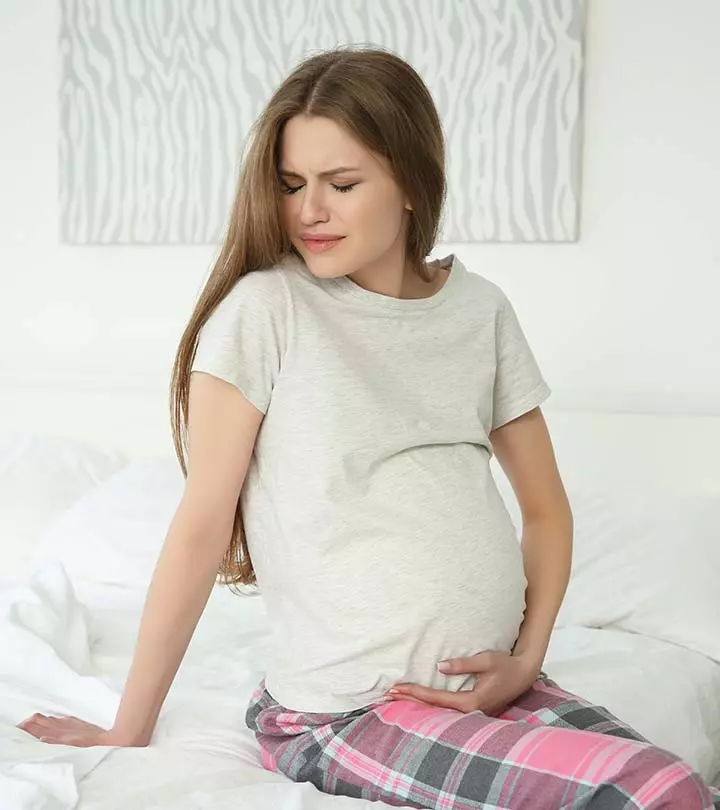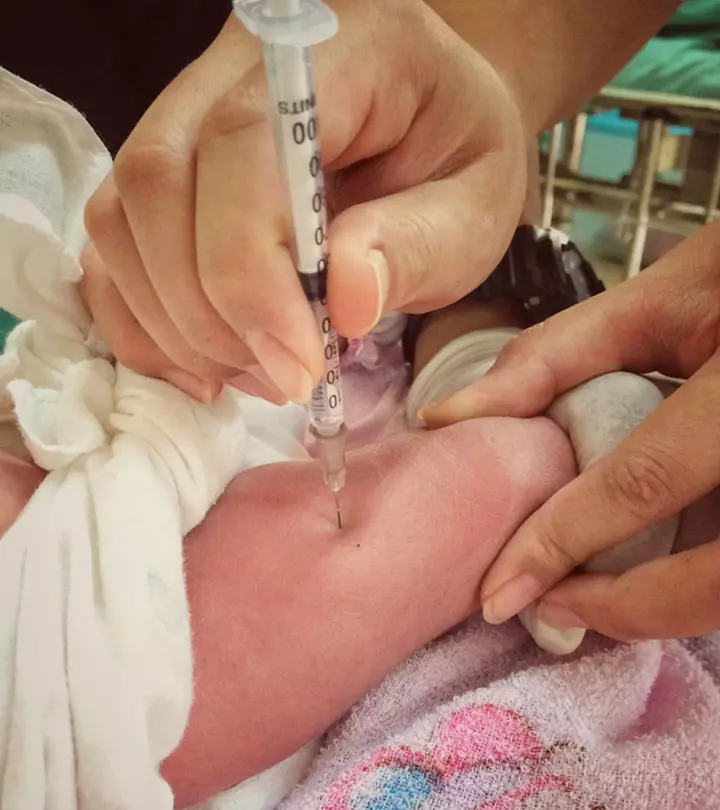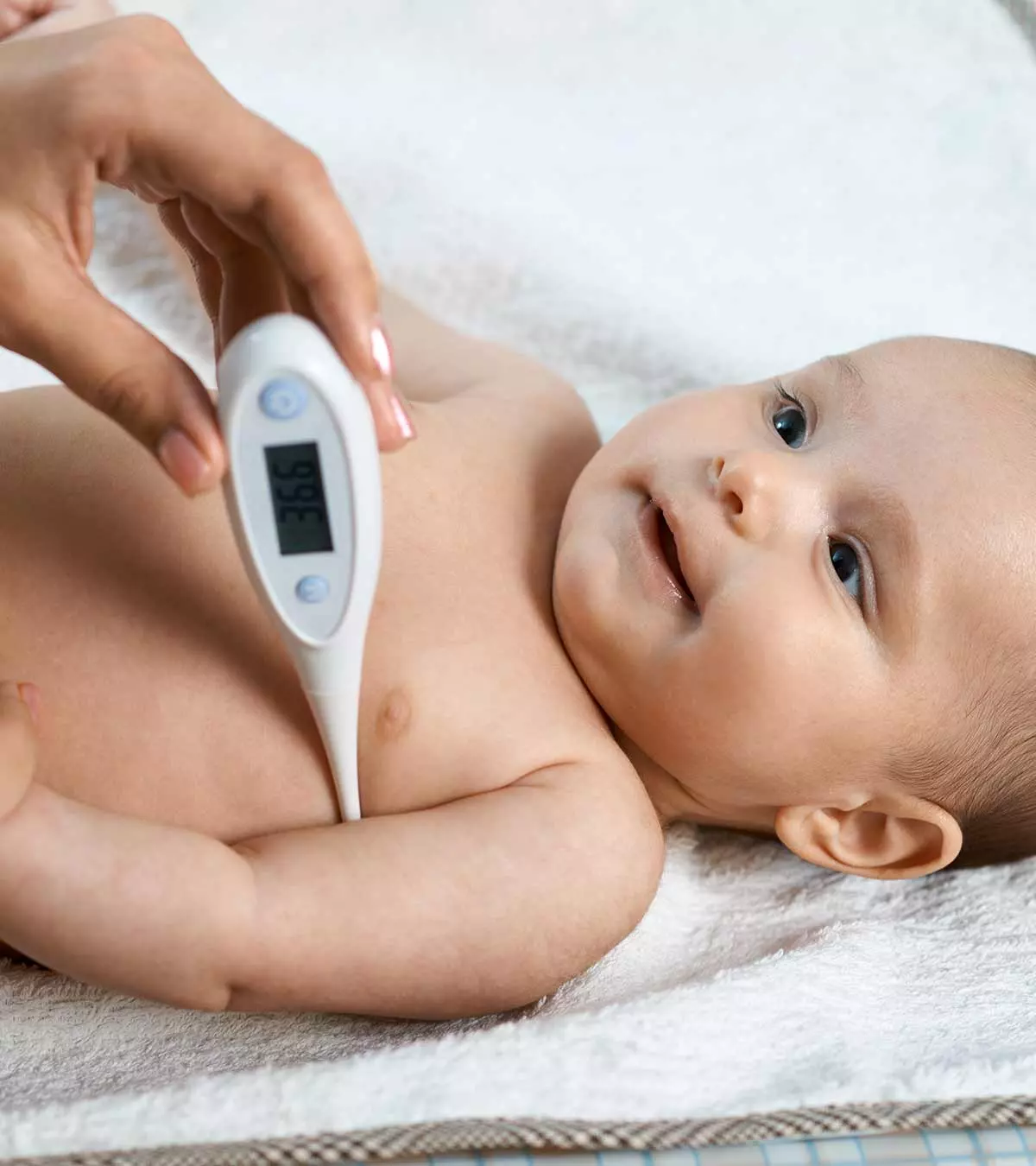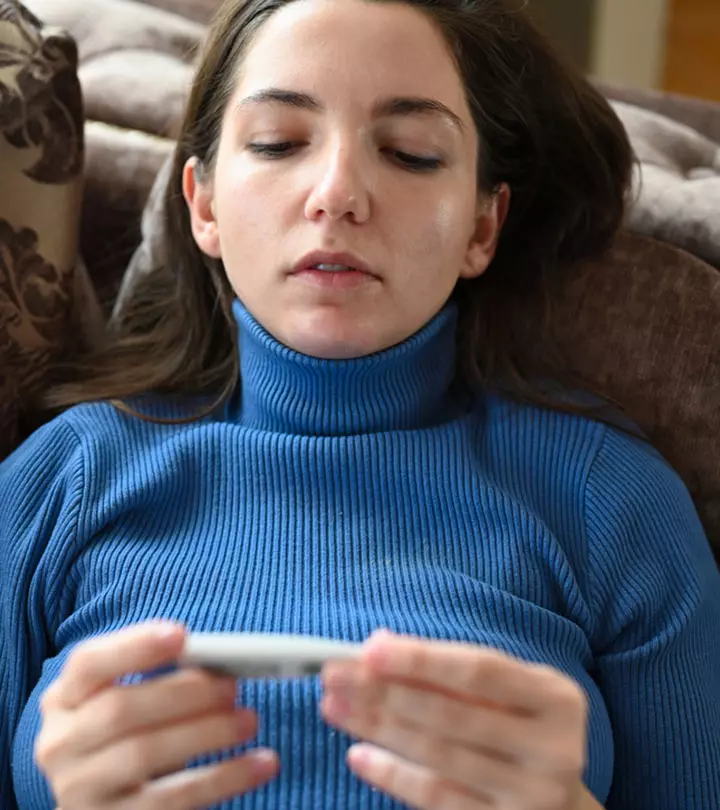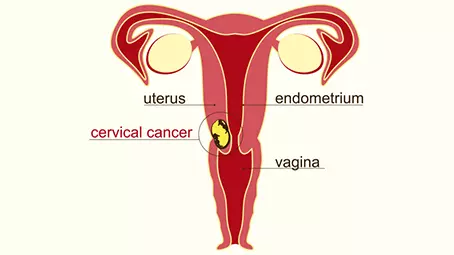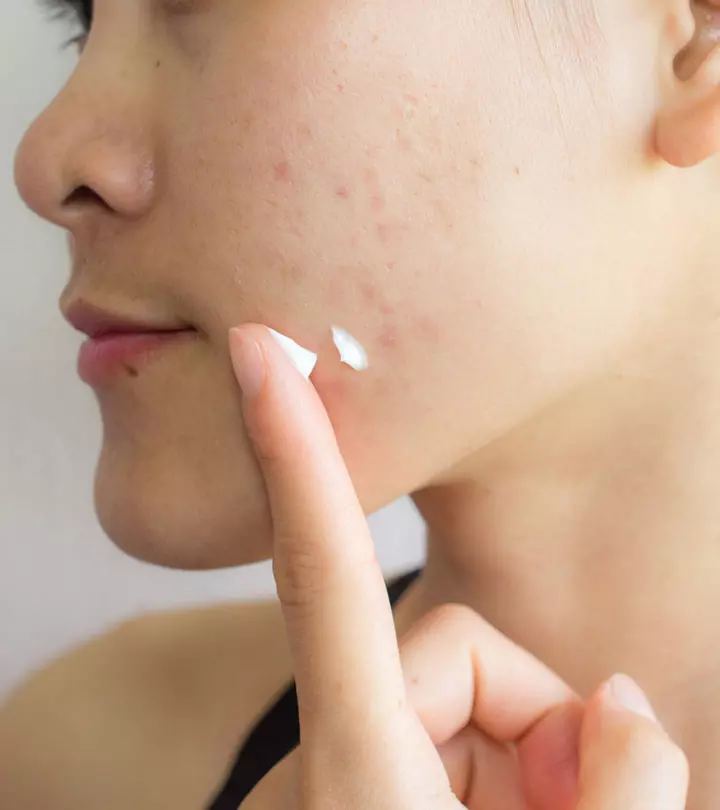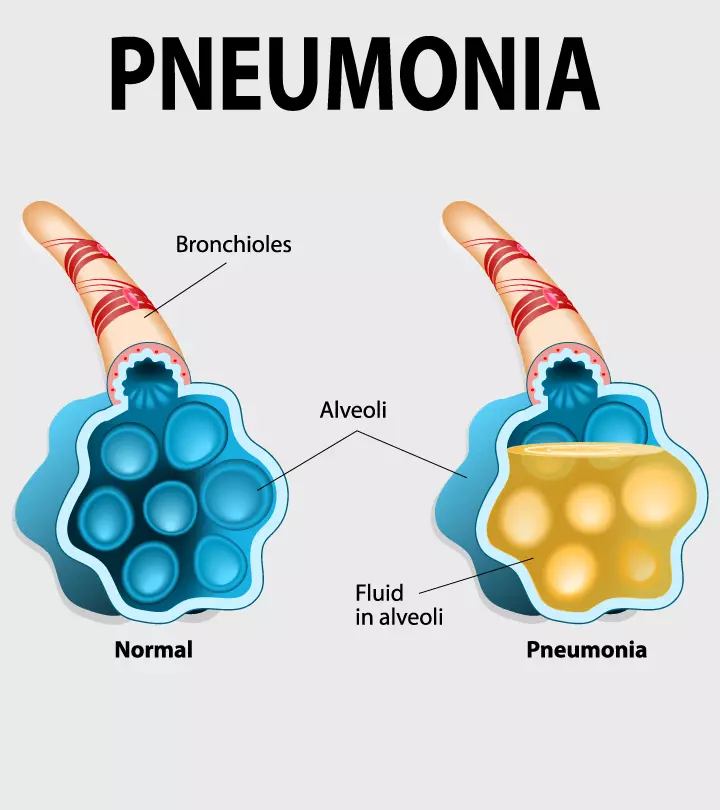
Image: Shutterstock
Moro (startle) reflex in babies is one of the several reflexes in babies and is not present in neurologically intact adults. Some other reflexes include the rooting reflex, sucking reflex, stepping reflex, grasp reflex, and tonic neck reflex, which occur at different stages of a baby’s development. These reflexes are an indication that the baby’s nervous system is functioning properly. A reflex is an involuntary reaction or movement (1).
Most responses of newborns or infants are reflexive. For example, when their cheek is stroked, they may turn their head on the same side, or when a finger is put in their mouth, they begin to suck on it. These are called primitive reflexes.
Read this post to learn about the Moro (startle) reflex, what it looks like, how it is initiated, and more.
Key Pointers
- Moro or startle reflex is usually seen in babies in response to loud noises or sharp movements.
- This reflex usually lasts until they are around two months and then goes away on its own.
- If moro reflex persists for more than six months, consult your doctor.
What Is A Moro Reflex In Infants?
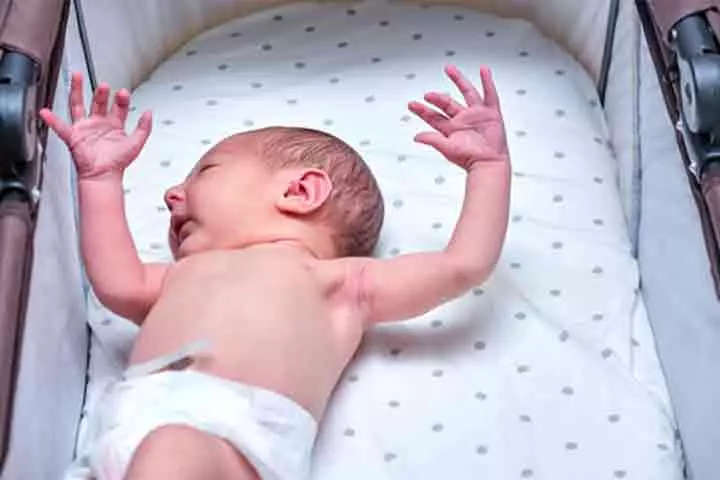
Moro or startle reflex is a type of involuntary response seen in newborns. It usually occurs when a baby is startled by a loud noise or movements that surprise the baby (2). The reflex was first described by Dr. Ernst Moro, an Austrian physician, and since then, has been called the Moro reflex(3).
What Does Moro Reflex Look Like In Babies?
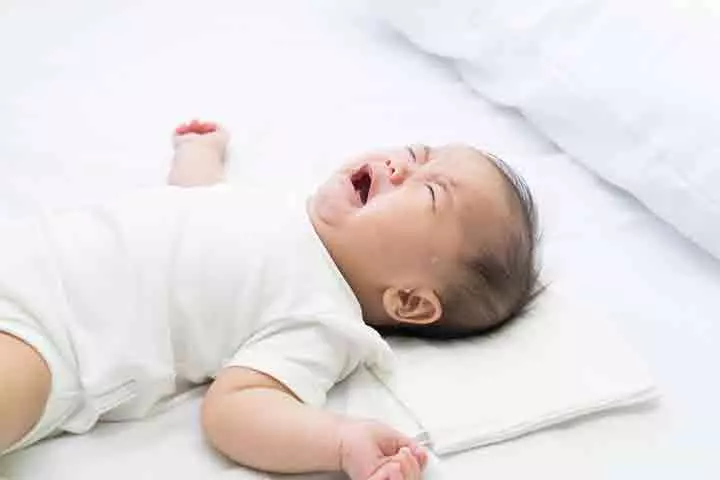
A sensory stimulus could startle the baby and trigger the Moro reflex, a protective mechanism that causes the baby to throw their head back and extend out their arms and legs. The baby’s arms extend sideways, while the palms face upwards with the thumbs flexed. The baby may also cry a little.
When the reflex ends, the baby pulls back their legs and arms with flexed elbows. The infant calms down and relaxes (1) (4).
What Triggers The Moro Reflex?
The following stimuli could trigger the Moro or startle reflex (1) (2).
- Loud, abrupt sound
- Baby’s own cry
- Sudden movement
- Sensation of falling (when being picked up or laid down)
 Quick fact
Quick factWhen Does Moro Reflex Start?
Moro reflex is present in newborns and peaks during the first month. Different babies show startle reflex in varying degrees of intensity (2).
Is Moro Reflex An Issue In Newborns?

It is a normal reflex among newborns. If the startle reflex is absent in newborns, it is a sign of concern. Doctors usually check for this startle response right after the baby’s birth and during subsequent visits. The absence of a startle reflex in newborns may be suggestive of the following (4).
- If absent in limbs on both sides of the body, it may indicate damage to the spinal cord or brain.
- If absent in limbs on one side of the body, it may indicate injury to the nerves that go from the lower neck and upper shoulder into the arms or a broken shoulder bone. It may also indicate other injuries, such as injuries to the nerves that go to the legs or fractures.
How Long Does Moro Reflex Last In Babies?
Moro reflex lasts up to two months of age and disappears by six months (2) (5). It is important to note that the presence of the startle reflex in older babies and children is considered abnormal, highlighting the importance of proper integration of primitive reflexes in early childhood development.
Keep a record of any unusual reactions in your baby and note if the Moro reflex continues past six months. These observations can help your child’s pediatrician make accurate assessments during check-ups.
When To Call A Doctor?
If the Moro reflex is absent or abnormal in babies, it may indicate underlying neurological problems and require further investigation. The doctor will perform a physical examination and discuss the medical history, including family medical history, labor and birth details, and other anomalies in the baby.
Further tests may be conducted to assess the baby’s muscles and nerves. These diagnostic tests may include shoulder X-rays or tests for brachial plexus injury (4).
You may also consult a doctor if the Moro reflex persists beyond six months. In such cases, the doctor could conduct tests to assess the baby’s normal growth and check for any regression in developmental milestones.
How To Reduce Moro Reflex In Infants?
An intense Moro reflex may sometimes interfere with the baby’s sleep. You may try the following to comfort your baby.
- Swaddling: The technique of wrapping a baby from the neck down in a light and breathable cloth is called swaddling. It offers comfort and warmth and prevents frequent awakenings that may occur due to the baby’s reflexes.

- Baby wearing: Baby wearing involves carrying a baby in a carrier that ensures skin-to-skin contact. Many believe that baby wearing calms the baby down, reduces crying, and builds connection.
- Room-sharing: The American Academy of Pediatrics recommends placing your baby’s cribs in the same room as yours (6). It may help make it easier to soothe the baby and control any disturbances, such as loud sounds, that may lead to the Moro reflex. According to the Centers for Disease Control and Prevention, the incidence rate of Sudden Infant Death Syndrome (SIDS) in the United States is 41%. Therefore, it’s important to remember that bed-sharing with babies should be avoided because it increases the risk of SIDS.
- Correct transferring methods: Abrupt movements are one of the reasons for startle reflex. Therefore, when transferring or shifting your baby, take extra care to avoid such movements. Be gentle and handle the baby carefully when placing them in their crib once they have fallen asleep. Place the head of the baby once their back is in contact with the mattress. This technique could help avoid the sensation of falling and prevent triggering the Moro reflex.
- Offering a pacifier: Once the baby is four weeks old, you may offer them a pacifier during naps and bedtime (7). The sucking action could calm babies and may make them less prone to startling while asleep.
 Caution
CautionAges And Stages Of Moro Reflex
- Birth to 1 month: Moro reflex is present at birth and peaks during the first month. The reflexes are frequent and prominent during this phase since the baby is new to the various external stimuli. Swaddling in such cases could soothe the baby.
- 2 to 3 months: At this stage, the baby is more familiar with your touch and presence. Hence, they will be calmer and sleep longer. However, if they get startled and wake up, make sure to gently calm them down with your touch and help them go back to sleep.
- 4 to 6 months: By this time, the babies have more control over their muscles and movements. The startle reflex begins to improve, and it is quite likely your baby may not have it beyond the age of two months. Nevertheless, the reflex gradually disappears by the age of six months old.
Other Types Of Newborn Reflexes
Let us discuss other types of reflexes seen in babies (1).
- Rooting reflex: Rooting reflex occurs when you touch a baby’s mouth (near the corners). The baby will turn their head or open their mouth to root in the direction of the touch. This reflex helps the baby find the bottle or breast for feeding. It usually disappears by the time the baby is four months old.
- Grasp reflex: In the case of grasping reflex in babies, when you touch the baby’s palm with a finger or object, they try to grasp the finger or the object. The grasp reflex of the hands disappears by the age of five to six months old, while the reflex of the toes stays up to nine to 12 months.
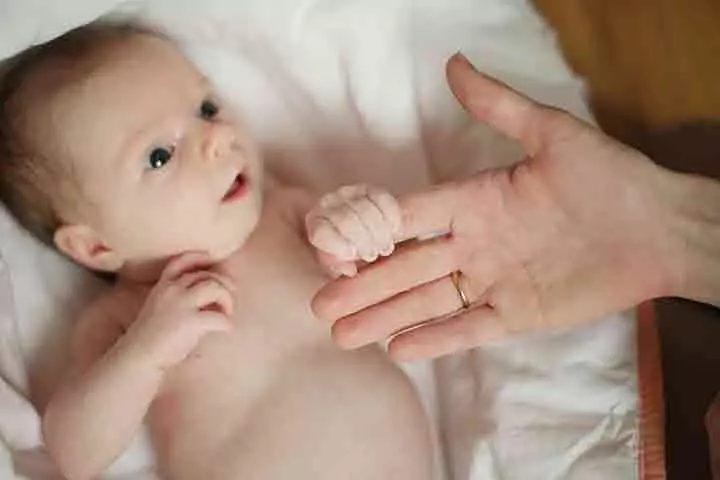
- Tonic neck reflex: When the baby’s head turns towards a direction, the arm on that side stretches out, while the arm on the opposite side bends at the elbow. It is also known as the fencing reflex and lasts till the baby is five to seven months old.
- Stepping reflex: The baby tries to take steps or dance when held upright or when made to stand on a surface with support. Step reflex in babies is also known as dancing or walking reflex, and it disappears by the time a baby is two months old.
- Suck reflex: Babies start to suck when the roof of their mouth is touched. This baby sucking reflex is not fully developed until 36 weeks of gestation. Therefore, in premature babies, this reflex is often weak or immature. The suck reflex usually lasts up to four to six months, which is the age when most babies are ready for solid food.
Frequently Asked Questions
1. What happens if the Moro reflex doesn’t go away?
If a Moro reflex doesn’t go away, it is called the retained Moro reflex. Children with retained Moro reflex may fear sudden loud noise, bright light, position changes, or sudden touch. They may also release more stress chemicals – cortisol and adrenaline, adversely affecting their memory, learning abilities, and immunity. Children may also sometimes develop hypersensitivity to sound, temperature, touch, or movement (8).
2. Can Moro reflex cause baby seizures?
No, Moro reflex does not cause baby seizures. Infantile spasm is a condition where babies experience seizures. The symptoms of these seizures resemble Moro reflex, so many parents get confused and miss recognizing the condition. It is important to recognize infantile spasms and get your baby treated at the earliest (9).
3. How can I soothe my baby if they startle easily due to the Moro reflex?
In addition to swaddling your baby to soothe them back to sleep, you could also try tucking their arms and legs back inside the covers to help them feel comfortable and relaxed. Also, holding them close to you may make them feel protected.
Moro reflex in babies is present since birth. It peaks at around two months of age and disappears when the baby is six months old. Doctors check for its presence at birth and at subsequent postnatal visits to check the baby’s development. If moro reflex is absent, it may indicate an underlying problem, such as spinal cord damage. In case your baby has an intense moro reflex, swaddling, babywearing, and sharing a room with your baby are a few effective ways to reduce it. Consult your pediatrician if moro reflex continues beyond the sixth month.
Infographic: Moro Reflex Triggering Factors In Infants
The Moro reflex, also known as the startle reflex, is one of the primitive reflexes of the baby and indicates the proper neurological development and function in babies. Explore the infographic below to learn when a baby shows this involuntary reflex and how it can be controlled to prevent sleep disturbances.

Illustration: Momjunction Design Team
Illustration: Moro Reflex In Babies: How Long It Lasts And When To Worry

Image: Stable Diffusion/MomJunction Design Team
References
1. Newborn Reflexes; Stanford’s Children Health
2. Newborn Reflexes; Healthy Children; American Academy of Pediatrics
3. Dick Hoefnagel and Dieter Luders, Ernst Moro; American Academy of Pediatrics
4. Moro reflex; U.S. National Library of Medicine
5. Christopher W. Edwards and Yasir Al Khalili, Moro Reflex; National Center for Biotechnology Information
6. Rachel Y. Moon, How to Keep Your Sleeping Baby Safe; Healthy Children; American Academy of Pediatrics
7. Pacifiers: Satisfying Your Baby’s Needs; Healthy Children; American Academy of Pediatrics
8. Retained Primitive Moro Reflex Effect On Development; Intermountain
9. About infantile spasms; UK Infantile Spasms Trust
10. Moro reflex; Mount Sinai
Community Experiences
Join the conversation and become a part of our nurturing community! Share your stories, experiences, and insights to connect with fellow parents.
Read full bio of Dr. Elena Shea
Read full bio of Dr Bisny T. Joseph
Read full bio of Rohit Garoo
Read full bio of Vidya Tadapatri










